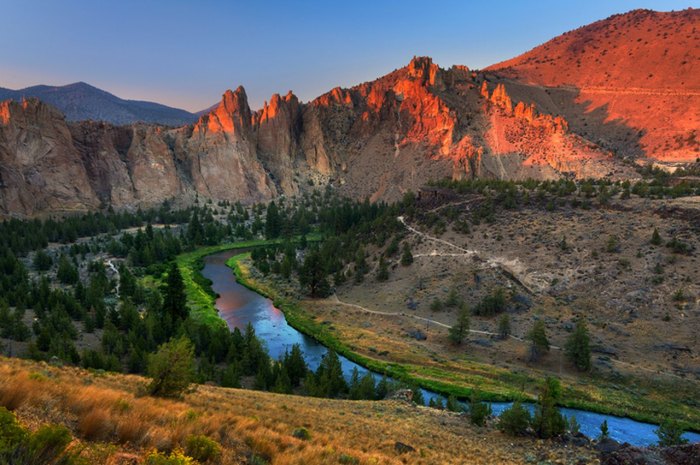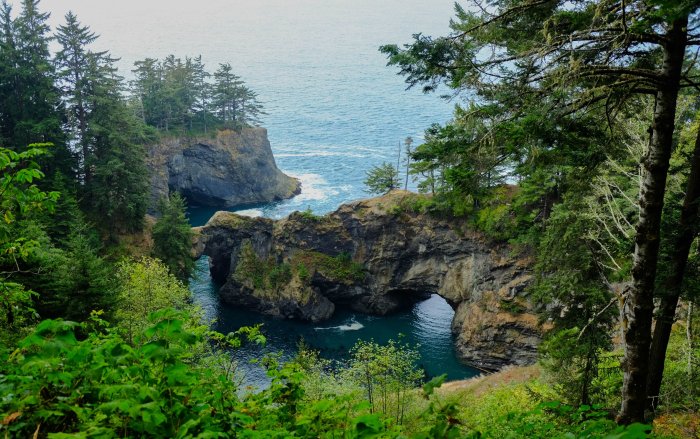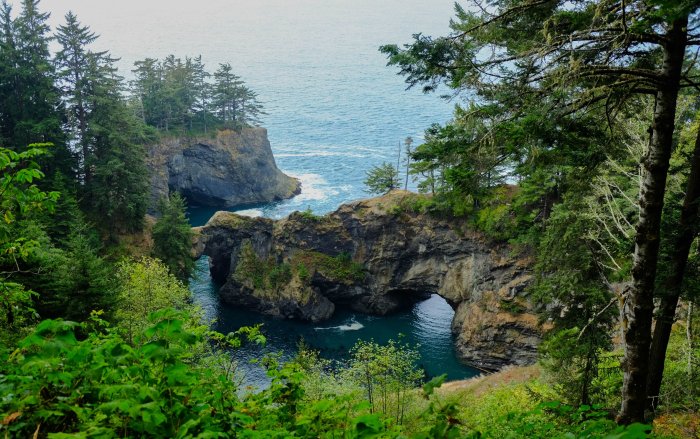Oregon natural – Oregon’s Natural Beauty and Heritage unveils the captivating tapestry of Oregon’s diverse landscapes, rich biodiversity, and the intricate relationship between its natural environment and cultural heritage.
From majestic mountains to pristine forests, meandering rivers to a rugged coastline, Oregon’s natural wonders beckon exploration and inspire awe.
Oregon’s Natural Beauty
Oregon is a state of breathtaking natural beauty, renowned for its diverse landscapes that span towering mountains, lush forests, pristine rivers, and a rugged coastline. Its unique geological formations and ecosystems create a tapestry of habitats that support an abundance of flora and fauna.
Mountains
Oregon’s mountainous terrain is dominated by the Cascade Range, a chain of volcanic peaks that stretch from north to south. Mount Hood, the highest peak in the state, stands at 11,249 feet and offers stunning views of the surrounding wilderness.
Other notable peaks include Mount Jefferson, Three Fingered Jack, and Mount Bachelor.
Forests
Oregon is home to vast expanses of temperate rainforests, characterized by towering Douglas firs, Western hemlocks, and red cedars. The Hoh Rainforest, located on the Olympic Peninsula, is one of the most biodiverse temperate rainforests in the world. Other notable forests include the Umpqua National Forest, the Siuslaw National Forest, and the Willamette National Forest.
Rivers
Oregon’s rivers play a vital role in the state’s ecosystem, providing habitat for fish and wildlife. The Columbia River, the largest river in the Pacific Northwest, forms the northern border of the state and supports a thriving salmon population. Other major rivers include the Willamette River, the Rogue River, and the Umpqua River.
Coastline
Oregon’s coastline stretches for over 360 miles, offering a diverse range of habitats. The rugged cliffs and sea stacks of the Oregon Coast Trail are a popular destination for hikers and nature enthusiasts. The sandy beaches and dunes of the Oregon Dunes National Recreation Area provide opportunities for recreation and wildlife viewing.
Flora and Fauna of Oregon

Oregon is home to a diverse range of plant and animal species, reflecting its varied ecosystems, from lush forests to arid deserts and coastal shores. The state’s flora and fauna have significant ecological importance and are subject to conservation efforts to protect their biodiversity.
Native Plant Species
- Douglas Fir: Oregon’s state tree, a majestic conifer known for its tall, straight trunk and dense foliage.
- Western Hemlock: A large evergreen tree common in moist forests, providing habitat for numerous animal species.
- Sitka Spruce: A coastal tree adapted to salt spray and wind, forming dense stands along the Pacific shoreline.
- Red Alder: A deciduous tree found in riparian areas, its roots forming symbiotic relationships with nitrogen-fixing bacteria.
- Oregon Grape: A low-growing shrub with glossy leaves and blue-black berries, providing food for wildlife.
Native Animal Species
- Black-tailed Deer: The most common deer species in Oregon, inhabiting forests and open areas.
- Roosevelt Elk: A large elk subspecies found in coastal forests, known for its distinctive antlers.
- California Sea Lion: A marine mammal found along the Oregon coast, forming large colonies on rocky shores.
- Coho Salmon: An anadromous fish that migrates from the ocean to freshwater streams to spawn.
- Western Pond Turtle: A semi-aquatic turtle found in ponds, lakes, and streams.
Ecological Significance and Conservation Status
Oregon’s native species play crucial roles in maintaining ecosystem balance and biodiversity. They provide food and shelter for other species, regulate water flow, and contribute to soil health. However, human activities such as habitat loss, pollution, and climate change threaten these species.
Conservation efforts are underway to protect Oregon’s flora and fauna, including habitat protection, species monitoring, and restoration projects. These initiatives aim to ensure the long-term survival of these valuable natural resources.
Outdoor Recreation in Oregon
Oregon offers a diverse range of outdoor recreational opportunities that cater to enthusiasts of all levels. From majestic mountains and pristine lakes to rugged coastlines and verdant forests, the state’s natural beauty provides an unparalleled backdrop for adventure.
The infrastructure and facilities supporting outdoor activities in Oregon are well-developed and accessible. Numerous hiking trails crisscross the state, ranging from easy day hikes to challenging multi-day treks. Campgrounds are strategically located throughout Oregon’s wilderness areas, providing a range of options for overnight stays.
State parks and national forests offer amenities such as picnic areas, boat launches, and visitor centers.
Hiking
Oregon’s vast network of hiking trails offers something for everyone, from leisurely strolls to strenuous ascents. The iconic Pacific Crest Trail traverses the state, offering a challenging but rewarding long-distance hiking experience. Mount Hood, Oregon’s highest peak, is a popular destination for day hikes and overnight backpacking trips.
Camping
Camping is a quintessential Oregon experience, with numerous campgrounds located in scenic settings throughout the state. From rustic campsites amidst towering trees to RV parks with full hookups, there are options to suit every preference. Oregon’s state parks and national forests offer a range of camping options, including tent sites, RV hookups, and yurts.
Fishing
Oregon’s abundant rivers, lakes, and coastline provide excellent fishing opportunities for both freshwater and saltwater species. The Columbia River is renowned for its salmon and steelhead fishing, while the Umpqua River is known for its exceptional trout fishing. The Oregon Coast offers a variety of fishing experiences, from surf casting for salmon to trolling for halibut.
Wildlife Viewing
Oregon is home to a diverse array of wildlife, including black bears, cougars, wolves, and a variety of bird species. Wildlife viewing opportunities are abundant in the state’s national parks, wildlife refuges, and scenic byways. The Oregon Coast Trail offers a unique opportunity to observe marine mammals such as whales, sea lions, and seals.
Natural Resources of Oregon: Oregon Natural

Oregon is endowed with a diverse range of natural resources, including vast forests, abundant minerals, and plentiful water sources. These resources have played a significant role in the state’s economy and environmental well-being.
The timber industry is a major contributor to Oregon’s economy, providing jobs and supporting local communities. The state’s forests are home to a variety of tree species, including Douglas fir, Western hemlock, and Ponderosa pine, which are used for lumber, paper, and other wood products.
Minerals
Oregon is also rich in minerals, including gold, silver, copper, and zinc. These minerals have been mined for centuries and continue to contribute to the state’s economy. Gold was discovered in Oregon in the mid-1800s and led to a gold rush that brought thousands of people to the state.
Today, Oregon is still a major producer of gold, and mining operations continue in several areas of the state.
Water
Water is a vital natural resource for Oregon. The state’s rivers, lakes, and streams provide water for drinking, irrigation, and hydroelectric power generation. The Columbia River, which forms the northern border of Oregon, is the largest river in the Pacific Northwest and provides a major source of hydropower for the region.
Oregon’s water resources are also important for recreation, including fishing, boating, and swimming.
Conservation and Environmental Protection in Oregon
Oregon’s natural beauty has inspired efforts to protect and preserve its environment for generations. From the rugged coastline to the snow-capped mountains, Oregon’s diverse ecosystems are home to a wide variety of plants and animals.
Government agencies, non-profit organizations, and individuals all play a vital role in conservation efforts in Oregon. The Oregon Department of Environmental Quality (DEQ) is responsible for enforcing environmental laws and regulations, while the Oregon Parks and Recreation Department manages state parks and natural areas.
Role of Non-profit Organizations
Non-profit organizations such as the Oregon Natural Resources Council (ONRC) and the Audubon Society of Portland work to protect Oregon’s environment through advocacy, education, and land conservation. These organizations work with landowners to protect critical habitats, conduct research on environmental issues, and advocate for policies that protect Oregon’s natural resources.
Role of Individuals
Individuals can also make a significant contribution to conservation efforts in Oregon. By reducing their carbon footprint, recycling, and volunteering for conservation organizations, individuals can help protect Oregon’s environment for future generations.
Sustainable Tourism in Oregon
Sustainable tourism in Oregon aims to minimize environmental impact and support local communities while providing a positive experience for visitors. Oregon’s commitment to sustainability is evident in various tourism practices that prioritize conservation and community engagement.
One key principle of sustainable tourism in Oregon is responsible land stewardship. This includes protecting natural areas, reducing pollution, and promoting responsible recreation. For example, many state parks and recreation areas have implemented measures to minimize damage to ecosystems and wildlife habitats.
Tourism Practices Supporting Local Communities
Oregon also promotes tourism practices that support local communities. This includes encouraging visitors to patronize local businesses, such as family-owned restaurants, shops, and guided tours. By supporting local businesses, tourists contribute to the economic well-being of Oregon’s communities and help preserve the unique character of each region.
Conservation and Environmental Protection, Oregon natural
In addition to supporting local communities, sustainable tourism in Oregon emphasizes conservation and environmental protection. Many tourism operators in Oregon offer eco-friendly experiences that allow visitors to enjoy the state’s natural beauty while minimizing their impact on the environment. For example, some tour companies use hybrid vehicles and promote responsible hiking practices to protect sensitive ecosystems.
Education and Awareness
Education and awareness play a vital role in promoting sustainable tourism in Oregon. Tourism organizations and state agencies provide resources and information to visitors about responsible travel practices. By educating visitors about the importance of conservation and community engagement, Oregon aims to foster a sense of stewardship and encourage visitors to make informed choices that support the long-term sustainability of the state’s natural and cultural resources.
Oregon’s Natural History
Oregon’s natural environment is a product of millions of years of geological events, climate changes, and human interactions. These events have shaped the state’s diverse landscapes, from the rugged coastline to the snow-capped mountains.
The geological history of Oregon begins with the formation of the North American continent about 1.1 billion years ago. The region that is now Oregon was part of a series of volcanic islands that were eventually welded together by tectonic forces.
Over time, these islands were uplifted and eroded, forming the mountains and valleys that characterize the state.
Climate Changes
Oregon’s climate has changed dramatically over time. During the last ice age, which ended about 10,000 years ago, Oregon was covered in glaciers. As the glaciers retreated, they left behind a landscape of lakes, rivers, and waterfalls.
The climate of Oregon has continued to change in recent centuries. The average temperature has increased by about 2 degrees Fahrenheit since the late 19th century. This warming trend is expected to continue in the future, and it is likely to have a significant impact on the state’s natural environment.
Human Interactions
Humans have been living in Oregon for thousands of years. The first inhabitants were Native Americans, who relied on the natural environment for food, shelter, and clothing.
European settlers began arriving in Oregon in the early 19th century. They brought with them new technologies and ideas that had a profound impact on the natural environment. The settlers cleared forests, built dams, and introduced non-native species.
The impact of human interactions on Oregon’s natural environment has been both positive and negative. On the one hand, humans have created many of the state’s most iconic landmarks, such as the Columbia River Gorge and Crater Lake.
On the other hand, human activities have also led to environmental problems, such as pollution, habitat loss, and climate change.
Oregon’s Natural Heritage
Oregon’s diverse and awe-inspiring natural landscapes, including majestic mountains, lush forests, sparkling rivers, and rugged coastline, hold immense cultural and historical significance, shaping the state’s identity and heritage.
These natural landmarks have served as gathering places, hunting grounds, and sources of sustenance for indigenous communities for centuries. The Columbia River, for example, was a vital transportation route for Native American tribes, connecting them with distant lands and facilitating trade and cultural exchange.
Mount Hood
Mount Hood, a majestic stratovolcano towering over the Cascade Range, is a sacred site for the Clackamas, Multnomah, and Warm Springs tribes. Its snow-capped peak and alpine meadows have been revered for generations, and the mountain holds deep spiritual and cultural significance.
Columbia River Gorge
The Columbia River Gorge, with its dramatic waterfalls, basalt cliffs, and old-growth forests, has been a place of awe and inspiration for centuries. The gorge was a major transportation route for Native American tribes, and its natural beauty continues to attract visitors from around the world.
Oregon Coast
Oregon’s rugged coastline, stretching over 360 miles, is a testament to the state’s natural diversity. The coast’s rocky headlands, sandy beaches, and towering sea stacks have provided sustenance and shelter to coastal tribes for millennia.
Willamette Valley
The Willamette Valley, a fertile agricultural region, has been home to Native American tribes for thousands of years. The valley’s rich soil and abundant resources supported thriving communities, and the area continues to play a vital role in Oregon’s economy and culture.
Environmental Challenges Facing Oregon
Oregon, renowned for its breathtaking natural beauty, faces a multitude of environmental challenges that threaten the integrity of its ecosystems and natural resources. These challenges include climate change, pollution, and habitat loss, each posing significant risks to the state’s environment.
Climate Change
Oregon is experiencing the adverse effects of climate change, manifested in rising temperatures, altered precipitation patterns, and increased frequency of extreme weather events. Rising temperatures have led to a reduction in snowpack, affecting water availability and exacerbating drought conditions. Altered precipitation patterns have resulted in heavier rainfall events, causing flooding and landslides, while also reducing summer precipitation, leading to drier conditions and increased wildfire risk.
The impacts of climate change extend beyond water resources and wildfire risk. Changes in temperature and precipitation patterns affect plant and animal species, leading to shifts in distribution and abundance. Sensitive ecosystems, such as alpine meadows and coastal habitats, are particularly vulnerable to these changes, potentially leading to biodiversity loss.
Pollution
Pollution from various sources poses another significant challenge to Oregon’s environment. Air pollution, primarily from vehicle emissions and industrial activities, contributes to respiratory problems and environmental degradation. Water pollution from agricultural runoff, industrial discharge, and sewage treatment plants impairs water quality, harming aquatic ecosystems and threatening human health.
Oregon’s coastal waters face challenges from marine pollution, including plastic waste, oil spills, and agricultural runoff. These pollutants harm marine life, disrupt ecosystems, and threaten the livelihoods of coastal communities that rely on fishing and tourism.
Oregon Natural Hot Springs, located in the breathtaking Cascade Mountains, offers a rejuvenating experience amidst pristine nature. For those seeking similar geothermal wonders worldwide, blue lagoon alternatives provide an array of options. From the azure waters of Iceland’s Blue Lagoon to the secluded hot springs of New Zealand, these destinations promise relaxation and revitalization.
While Oregon Natural Hot Springs stands as a unique gem in its own right, these alternatives offer a diverse range of experiences for those seeking the therapeutic benefits of geothermal waters.
Habitat Loss
Oregon’s natural habitats are under increasing pressure from urbanization, agricultural expansion, and infrastructure development. Habitat loss and fragmentation pose significant threats to wildlife populations, reducing their ability to find food, shelter, and mates. Sensitive species, such as the spotted owl and the Oregon silverspot butterfly, are particularly vulnerable to habitat loss.
The conversion of natural habitats to other uses also affects ecosystem services, such as water filtration, carbon sequestration, and pollination. The loss of these services can have far-reaching consequences for both human and natural communities.
The Future of Oregon’s Natural Environment
The future of Oregon’s natural environment is uncertain, but it is likely to be shaped by a number of factors, including climate change, population growth, and technological advancements. Climate change is expected to have a significant impact on Oregon’s climate, with warmer temperatures and less precipitation.
This could lead to changes in the state’s plant and animal life, as well as its water resources.
Population growth is also expected to have a significant impact on Oregon’s natural environment. As the population grows, there will be more demand for land, water, and other resources. This could lead to the loss of natural habitat and the degradation of air and water quality.
Technological advancements could also have a significant impact on Oregon’s natural environment. New technologies could be used to develop more sustainable ways to use resources, or they could be used to create new environmental problems.
Conservation and Sustainable Practices
Conservation and sustainable practices will play a key role in shaping the future of Oregon’s natural environment. Conservation practices can help to protect natural habitat and endangered species. Sustainable practices can help to reduce the impact of human activities on the environment.
By working together, we can help to ensure that Oregon’s natural environment is protected for future generations.
Closing Summary
Oregon’s natural environment is a testament to the interconnectedness of life and the delicate balance that sustains it. Through conservation efforts, sustainable practices, and a deep appreciation for its natural heritage, Oregon continues to preserve and protect its invaluable natural treasures for generations to come.
FAQ Resource
What is Oregon’s state flower?
Oregon Grape
What is the highest mountain in Oregon?
Mount Hood
What is the largest lake in Oregon?
Crater Lake



